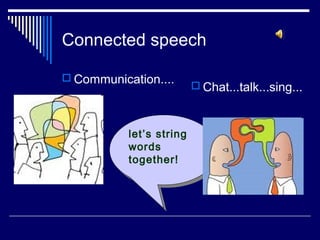Connected speech features
- 1. Connected speech ? Communication.... ? Chat...talk...sing... let¡¯s string let¡¯s string words words together! together!
- 2. What is connected speech? ? Fluent speech flows with a rhythm and the words bump into each other. ? To make speech flow smoothly the way we pronounce the end and beginning of some words can change depending on the sounds at the beginning and end of those words.
- 3. Features of connected speech Linking sounds ? Consonant to vowel linking ¨C when the first word ends with a consonant sound and the second word begins with a vowel sound. E.g. Fried egg / a box oveggs / cupov tea /doyer? We change the sounds to make it flow! ? Vowel to vowel linking ¨Cwhen the first word ends in a vowel and the next words begins with a vowel sound. We add a ¡®w¡¯ or ¡®y¡¯ sound.E.g.¡¯ go in¡¯ / say it/do it/two eggs/ hiya! / cudyer? ? Consonant to consonant linking ¨C when the first word ends in a consonant and the next one begins with a consonant sound. We don¡¯t hear both separately, we just hear one. E.g. We only hear one /t/ E.g. A bit tired /lot to do
- 4. Features of connected speech Disappearing sounds ? In rapid speech the /t/ or the /g/ sound at the end of the word often disappears completely if there are consonant sounds either side. e.g. next week / can¡¯t swim/ going for . ? This also happens with the /d/ sound. e.g. sandwich ¨C san(d)wich. Fish and chips ¨C fish an chips/bread an cheese. ? The /h/ sound is often deleted. E.g. You shouldn¡¯t (h)ave told (h)im/ We could (h)ave. ? The unstressed schwa(?) is often lost. E.g. t(o)night/ got t(o)ave.
- 5. Features of connected speech ? Weak sounds ? There are a large number of words in English which can have a ¡®full¡¯ form or a ¡®weak¡¯ form. This is because English is a stress timed language, and in trying to make the intervals between stressed syllables equal, to give us rhythm, we tend to swallow non-essential words. Thus, we lose pronouns, conjunctions, prepositions, auxiliaries and articles. E.g. ? And ¨C a table ¡®n chair ? Can ¨C She c/?/n speak English ? Of ¨C A cup ov coffee ? Have ¨C Av you finished? ? Should ¨C You sh/?/d av told me. ? The verb ¡®to be¡¯ ¨C I¡¯m He¡¯s
- 6. Features of connected speech ? Changing Sounds ? Listen to two words said individually, then listen to them in a sentence ¨C Can you hear the difference? ? Sometimes the sound at the end of the first word takes on the quality of the sound at the beginning of the second word. e.g. She¡¯s a good girl. ? This is to do with the place in the mouth where we make the sounds. E.g. When we say /b/ or /p/ we can feel that both your lips are pressed together. ? When we say /t/ or /d/ or /n/ we can feel that our tongue is touching above our top teeth. ? When you say /k/ or /g/ or the ¨Cng sound, we can feel the back of our tongue touching the roof of our mouth.
- 7. Examples: ? Good girl ¨C goog girl/goob boy ? Ten pounds ¨C tem pounds ? Good mornin ¨C goob mornin ? Not quite ¨C nok quite ? So..
- 8. To sum up.... ? So let¡¯s connect and ? Connected speech chat!!! consists of: ? Linking sounds ? Disappearing sounds ? Weak sounds ? Changing sounds
- 10. Helpful websites to chat and practice! ? www.bbclearningenglish.com ? www.englishcentral.com ? www.elllo.org/ ? www.cambridgeenglishonline.com/Phon etics_Focus/
- 11. Bibliography ? Books ? Underhill, A. (2005). Sound foundations. Oxford. Macmillan Publishers Ltd. ? Internet sites ? Talk about English (July 2005). Retrieved 5 June 2010 from ? www.bbclearningenglish.com ? Connected speech.(2006). Retrieved from ? www.eslsite.com/rd/Pronounciation/connected_speech.html ? Learning English ¨C I would like to buy a hamburger. Retrieved from www.youtube.com











